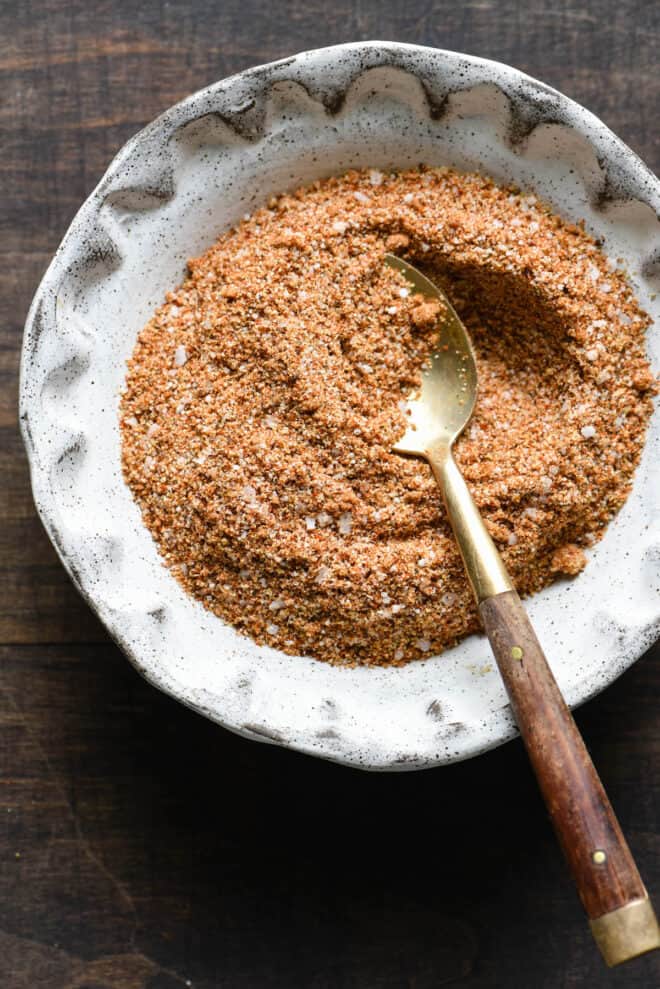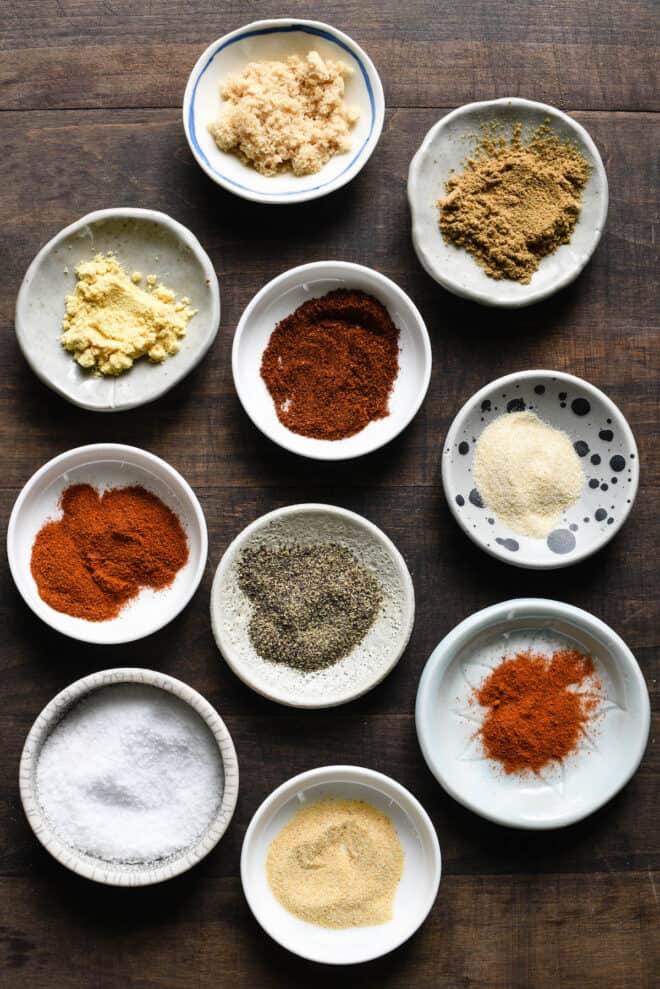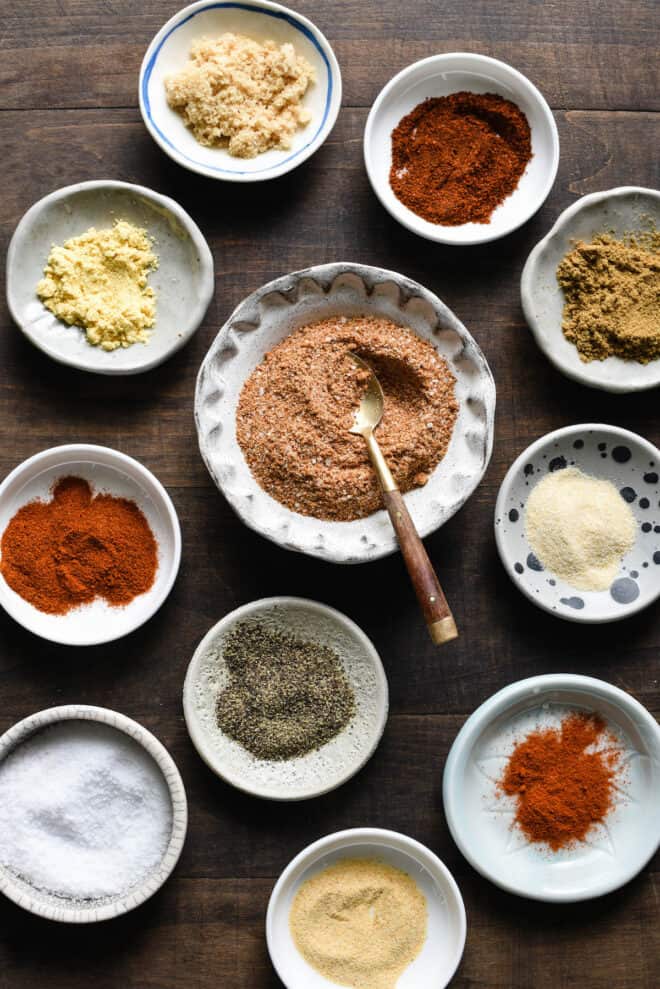Best Dry Rub for Ribs
This homemade dry rub for ribs is customizable, cost-effective, and can also be used for chicken, brisket, pork shoulder and even burgers.
“This rub is fantastic! Never any leftovers.”
—HC
Why you need to make your own Rib Rub
I make my own dry rub for ribs for the same reason I make my own salad dressings, sauces and marinade: I can control what’s in it!
I’ve purchased pre-packaged meat rubs before, and sometimes they’re OK. But often, I’m simply not happy with the flavor.
Sometimes they’ll only taste like salt and not much else, or sometimes there is just wayyyy too much cumin, and it overpowers everything else in the mixture.
When I make my own dry rub recipe, I can go heavier on the spices that I really like (chili power, garlic powder, onion powder) and go lighter or omit the ones I’m not as crazy about.
Use this best rib rub recipe in conjunction with either my oven baby back ribs or slow cooker baby back ribs recipe.
Why You Will Love This Dry Rub for Ribs
- Buying pre-made rubs can be expensive, especially if you’re hosting a barbecue and need a large amount. Making your own rub is cost-effective, using spices you likely already have in your pantry.
- This rub isn’t just for ribs! Its versatile flavor profile works wonders on a variety of meats, including chicken, beef brisket, pork shoulder, even burgers!

The Best Rub Recipe for Baby Back or Spare Ribs!
Even though salt is the predominant ingredient in this dry rub for ribs (as it is in most dry rubs), I sometimes refer to this as a brown sugar rib rub, since there’s quite a bit of that too.
The molasses flavor of brown sugar is a nice way to add a touch of sweetness to savory foods.
The balance of the salt and the sugar in this rib seasoning means the finished ribs have a sweet and savory quality. The chili powder and paprika give the ribs a deep brick red color, while the ground mustard and cayenne give them a little kick.
I most often use this dry rub for ribs recipe on baby back ribs, simply because they’re my favorite. But this brown sugar rib rub recipe can also be used on spare ribs. This article from Eater does a good job of explaining the difference between baby back ribs and spare ribs.

What you’ll need to make the Best Dry Rub For Ribs
A full recipe card, including exact ingredient amounts, appears at the bottom of this post.
- kosher salt – this enhances the overall flavor of the meat, as well as all of the other ingredients in the rub.
- chili powder – this adds a bit of heat and a subtle smokiness, which is always a great flavor pairing for ribs.
- garlic powder – this adds a savory and aromatic element to the best rib rub.
- light brown sugar – this adds a touch of sweetness but also helps the meat caramelize as it’s cooking.
- onion powder – adds a subtle onion flavor and contributes to the overall savory taste.
- paprika – adds a rich red color and mildly sweet, smoky flavor.
- ground cumin – adds an earthy depth of flavor and warmth.
- ground mustard – adds a tangy flavor that makes this the best dry rub for ribs.
- ground black pepper – adds a mild heat and pairs well with the other spices.
- cayenne pepper – adds a hot and spicy kick. The amount can be adjusted according to personal preference for heat.
Dry Rub Variations and Customizations
While this dry rub for ribs is perfect as it is, you can also customize it and try different variations to suite your taste preferences. Here are a few ideas for different varieties:
- SPICY – Add more cayenne pepper, as well as a pinch of red pepper flakes.
- SMOKY – Use smoked paprika in place of traditional paprika to add a deep smoky flavor to the meat.
- HERBY – Experiment with adding dried herbs like oregano, rosemary and thyme to add an herbaceous element to the rub.
Home Chef Tips for this Rib Rub Recipe
- When you’re ready to use your rub, make sure your ribs are dry by patting them down with paper towel. Then, apply the rub generously, ensuring it covers every nook and cranny.
- Don’t forget the sides for ribs to complete your meal!

Save This Recipe!
Other ways to use the Best Rib Rub
While this rib rub recipe was developed specifically for ribs, it’s quite versatile and can be used to enhance a variety of meats and even vegetables. Here are a few ideas:
- PORK CHOPS – Rub pork chops with this dry rub before cooking to add a sweet and savory flavor to your chops.
- CHICKEN – this is one of my favorite seasonings for grilled or even baked chicken.
- FRENCH FRIES – it sounds strange, but tossing homemade or frozen French fries with this dry rub for ribs really takes the fries to the next level, and my family does it all the time!
Storing Rib Rub
Dry rub for ribs can be stored at room temperature in an airtight container. It can last up to six months, but for best flavor, try to use it within three to four months.

Dry Rub for Ribs FAQs
At least 15 minutes, but no longer than 12 hours. The longer the dry rib sits on the ribs, the deeper the flavor will be. If you’re planning to smoke or grill the ribs with JUST the dry rub (no sauce), you’ll probably want a more pronounced flavor from the rub, since it’s your only flavoring agent. In that case, I usually rub the ribs in the morning and refrigerate them all day before grilling. But, if you’re planning to slather the ribs with a thick and sticky barbecue sauce (like my country style ribs in oven or root beer ribs), you can cook the ribs 15 minutes after you rub them.
Don’t let the rub sit on the meat any longer than about 12 hours or so. Any more than that, and the meat can start to dry out, similar to a curing effect.
Both dry rubs and wet rubs for ribs have their merits, so it ultimately comes down to personal preference. A dry rub helps create a flavorful crust, and is simple to prepare and store for future use. A wet rub gives you the opportunity to include things like citrus juice, vinegar and Worcestershire sauce. It can create a glaze on the outside of the meat, but needs to be refrigerated and doesn’t have a long shelf life. I prefer the simplicity and ease of storage that comes with a dry rub for ribs.
More Foxes Love Lemons Favorites

Dry Rub Recipe
Save This Recipe!
Ingredients
- 2 tablespoons kosher salt
- 1 tablespoon chili powder
- 1 tablespoon garlic powder
- 1 tablespoon light brown sugar
- 1 tablespoon onion powder
- 1 tablespoon paprika
- 2 teaspoons ground cumin
- 2 teaspoons ground mustard
- 1 teaspoon ground black pepper
- ½ teaspoon cayenne pepper
Instructions
- In small bowl, stir together all ingredients.
- Store at room temperature, in airtight container, for up to 1 month.
Notes
- When you’re ready to use your rub, make sure your ribs are dry by patting them down with paper towel. Then, apply the rub generously, ensuring it covers every nook and cranny.
- Don’t forget the sides for ribs to complete your meal!



This rub is fantastic! Never any left overs. Thanks Lori
I’m so glad to hear it’s a hit!
Way too salty for our taste. Will cut salt in half and add something for a little tang next time.
Thanks for the feedback, I appreciate it!
Great stuff! From my experience, I can also recommend using/adding ground clove for the rub as well! 1 tablespoon does the job! Amazing taste 🙂
Love that idea, Marek. Have a great weekend!
I also added the cloves to the recipe and put it on chicken thighs all around and under the skin, then cooked on a sheet 6 thighs at 270 for 2 1/2 hours then smoked up a little on the charcoal…we did not need bbq sauce, ..it was Awsome.,.,
Love this idea, Richard. So glad this turned out well for you.
I Like this rub —last night I made baby back ribs -slow cooked for 4 hrs at 285–then I basted with a Canadian sauce I found yrs ago—it’s basically a taste or what you get in the Chinese restaurants–cider vinegar- brown sugar – mustard and lots of garlic honey and slow cook on the stove – mason jars also for this and keeps in the fridge forever – good drizzle over chicken as well——my husband thought the ribs werre the best ever—it’s all in the rub first while slow cooking
Oh wow, Susan, your ribs sound AMAZING! I know just what you mean about that Chinese restaurant flavor 🙂
Now that Ihave the right rub, I will need yur Chinese Restaurant sauce
Lori, I’m just like you in hating commercial packaging. I keep everything I can in mason jars (and a few things like rolled oats in plastic containers because they are bigger). Mason jars make it so much easier to store food neatly, as well as making the food visible. They have enabled me to keep a neat, organized pantry for 3 years now. The other thing I like is that I can buy bigger packages of things and just refill the jars when they are empty (I have an accessory pantry in the garage). After you called your dry rub a brown sugar rub, I was glad to see it doesn’t have much sugar in it. I’ve given up trying to make good ribs because we have a local restaurant that does a fantastic job with them. But I’m saving this recipe because who knows when I’ll need it. Who knows, maybe I can get my husband to use it in place of Jane’s Crazy Salt?
Yes, another mason jar lover! I do the same thing with an accessory pantry and refilling the jars. Jars just make me happy.
And no, there’s really not too much brown sugar in this rib. Just enough for a little sweetness, but mostly it’s just spices!